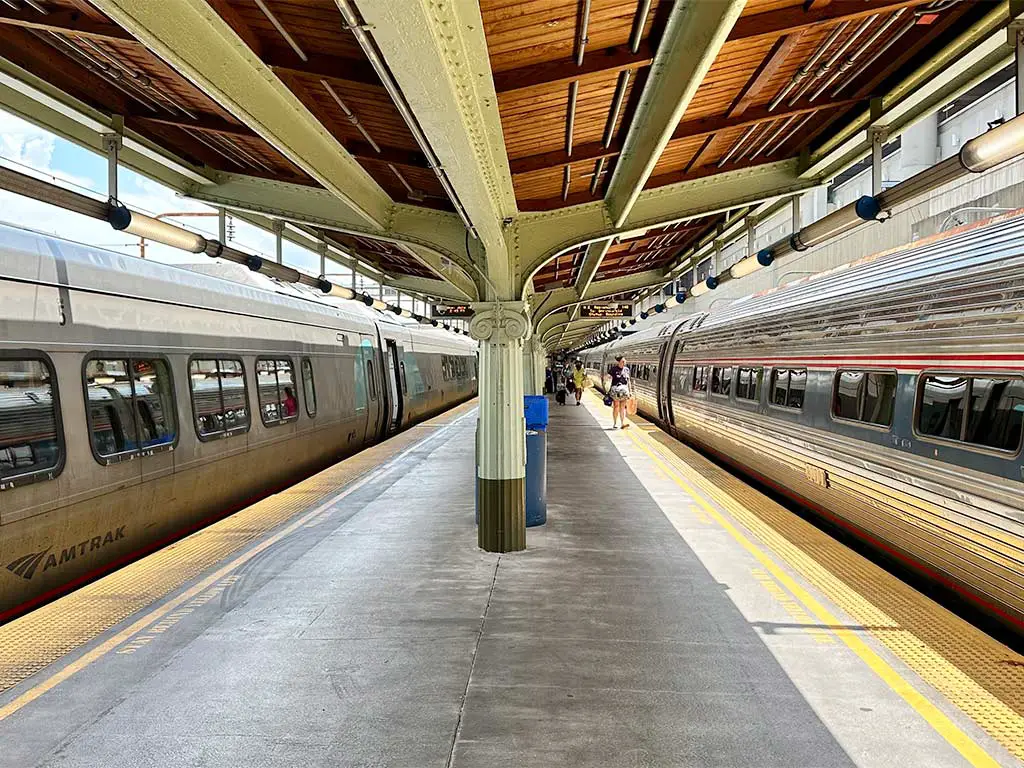If you’re curious about the rich history of Union Station in Washington, DC, you’re in for a fascinating journey through time.
From its opening in 1908 to the extensive rebuilding between 1981 and 1989, Union Station has stood as a symbol of architectural grandeur and transportation innovation. The station was electrified on January 28, 1935, marking a significant milestone in its evolution.
Union Station not only serves as a hub for the Washington Metro and DC Streetcar but also offers convenient bike transport options and access to the Metropolitan Branch Trail.
With 2448 parking spaces, 180 bicycle facilities, and accessibility features, Union Station caters to diverse transportation needs.
Whether you’re a history enthusiast or a commuter, exploring Union Station unveils a tapestry of the past woven into the fabric of modern-day transportation.
Historical Overview of Union Station

Union Station in Washington, D.C., has a rich history that reflects its importance as a transportation hub and architectural landmark.
Here’s an overview of its historical development:
Early Plans and Construction
In the early 1900s, ambitious plans were set in motion to construct a grand railway station in Washington, DC. The architectural marvel we now know as Union Station was the result of these visionary plans.
Designed by architect Daniel Burnham, Union Station’s construction commenced in 1903, and after five years of meticulous work, the station finally opened its doors to the public in 1908.
The station’s Beaux-Arts style and monumental scale solidified its place as a symbol of Washington, DC’s architectural splendor.
Opening and Early Operations
Upon its opening, Union Station quickly became the primary transportation hub for the capital city and the gateway to the nation’s capital for travelers from near and far.
The station bustled with activity as trains arrived and departed, connecting people to various destinations across the country.
Its grand Main Hall, adorned with majestic columns and a lofty ceiling, exuded a sense of elegance and served as a focal point for the station’s operations.
The Decline and Its Causes
Despite its early success, Union Station faced a period of decline in the latter part of the 20th century. Various factors contributed to this decline, including changes in transportation trends, neglect of maintenance, and the emergence of alternative travel options.
The station began to lose its luster, and efforts were needed to revive its former glory and ensure its continued relevance in the modern era.
Restoration Efforts Through the Years
Recognizing the historical and architectural significance of Union Station, restoration efforts were initiated in the 1980s to revitalize the station and preserve its heritage.
Major renovations and refurbishments took place, including regilding the iconic ceiling with high-quality gold, reconfiguring the layout of the main hall, and modernizing amenities to meet contemporary standards.
These restoration endeavors breathed new life into Union Station, transforming it into a vivid transportation hub that seamlessly blends its storied past with modern convenience.
Architectural Significance

Union Station in Washington, D.C., holds significant architectural importance, blending classical design elements with modern functionality to create a timeless and iconic landmark.
Here’s a closer look at its architectural significance:
Beaux-Arts Influence
The architectural design of Union Station in Washington, DC reflects the Beaux-Arts style, characterized by grandeur and opulence.
Architect Daniel Burnham’s vision for the station emphasized classical elements, such as symmetry, grand colonnades, and intricate detailing.
The Beaux-Arts influence is evident in the station’s majestic facade, featuring imposing arches, ornate decorations, and a sense of monumental scale.
This style was popular during the early 20th century and aimed to evoke a sense of civic pride and cultural sophistication.
Union Station’s architectural significance lies in its embodiment of Beaux-Arts principles, showcasing the city’s cultural and artistic aspirations during that era.
Iconic Main Hall
The main hall of Union Station is one of its most prominent features. With its soaring coffered ceilings and grand arched windows, it creates an atmosphere of elegance and grandeur.
The sheer size of the hall adds to its impressive presence, welcoming travelers with a sense of awe and majesty.
The intricate details of the main hall’s architecture, such as the ornate moldings and majestic chandeliers, further enhance its grandeur and historical significance.
Visitors can’t help but be transported back in time to an era of opulence and sophistication as they step into this magnificent space.
Concourse Area
The concourse area of Union Station is another noteworthy feature, showcasing meticulous attention to detail and craftsmanship.
Adorned with marble floors and intricate mosaics, it provides a stunning backdrop for passengers as they navigate the station.
The concourse’s design reflects both functionality and beauty, enhancing the overall experience for visitors. The grand arches and high ceilings in the concourse area of Union Station evoke a sense of grandeur and elegance, transporting visitors to a bygone era of luxury train travel.
The natural light streaming in through the expansive windows further enhances the ambiance, creating a welcoming and awe-inspiring space for travelers to enjoy.
Exterior Facade
The preservation of Union Station’s exterior facade is crucial to maintaining its historical and architectural integrity.
The classic Beaux-Arts elements, including ornate detailing and grand entrances, contribute to the station’s timeless appeal.
By preserving these architectural features, Union Station honors its past while remaining a vivid hub of activity in Washington, D.C.
Furthermore, the iconic clock tower of Union Station serves as a prominent symbol of the city’s history and a focal point for visitors.
Its elegant design and intricate craftsmanship highlight the station’s significance as a historical landmark in Washington, D.C.
Symbol of Architectural Excellence
Union Station’s blend of classical design elements and modern functionality has solidified its status as a symbol of architectural excellence and civic pride.
Its timeless beauty and historical significance make it a beloved landmark in Washington, D.C., attracting visitors from around the world.
As a testament to the city’s rich heritage and cultural legacy, Union Station continues to captivate and inspire all who pass through its doors.
Union Station in Modern Times

In modern times, Union Station in Washington, D.C., continues to serve as a bustling transportation hub while also embracing new roles as a vivid commercial and cultural center.
Here’s a closer look at its significance in the contemporary era:
Current Services and Functions
Union Station in Washington, DC, continues to serve as a vital transportation hub, accommodating millions of passengers, tourists, and shoppers annually.
With more than 37 million visitors passing through every year, the station remains a key landmark in the city, attracting a significant number of travelers and commuters.
Despite its historical significance, Union Station faces challenges during peak travel times, leading to long departing queues and visible passenger frustration due to overcrowding.
Recent Renovations and Future Plans
The Washington Union Station 2nd Century plan represents a comprehensive initiative aimed at enhancing the station’s infrastructure to triple passenger capacity and double train capacity over the next two decades.
This modernization project builds upon the 2012 Master Plan, which outlined growth goals for the station in the near and long term.
Various projects under the 2nd Century plan focus on modernizing and expanding station facilities to meet current demands and improve the overall passenger experience.
One of the notable restoration efforts involved a public-private partnership, with contributions from Amtrak, Union Station Venture, and the District of Columbia.
Union Station in Popular Culture

Union Station in Washington, D.C. has been featured prominently in various forms of popular culture, from movies to television shows.
Its iconic architecture and historical significance have made it a favorite filming location for directors and producers looking to capture the essence of the city.
Movies
“Union Station” (1950): This film noir classic starring William Holden showcased Union Station as the backdrop for a thrilling crime drama.
“The Pelican Brief” (1993): In this legal thriller, Union Station’s grandeur was captured on screen, adding to the dramatic impact of the storyline.
Television Shows
“The West Wing”: Several episodes of this political drama series featured scenes shot at Union Station, portraying it as a bustling hub of activity.
“Bones”: The popular crime procedural series often used Union Station as a filming location, highlighting its architectural beauty and historic charm.
Music Videos
“Runaway Train” by Soul Asylum: The music video for this hit song includes scenes filmed at Union Station, adding a touch of nostalgia and emotion to the visuals.
Books
“The Lost Symbol” by Dan Brown: In this bestselling novel, Union Station serves as a prominent location where key events unfold, blending fiction with the station’s real-world allure.
Cultural Significance
Union Station’s presence in popular culture not only reinforces its status as a significant landmark but also showcases its timeless appeal and versatility as a setting for artistic expression.
Its architecture, history, and atmosphere continue to captivate audiences across different mediums, solidifying its place in the collective imagination of both residents and visitors alike.
Union Station’s portrayal in movies, TV shows, and literature adds to its allure as a symbol of Washington D.C.’s rich history.
Its iconic design and storied past make it a favorite backdrop for creative works, ensuring its enduring legacy in the hearts and minds of many.
Frequently Asked Questions
What transportation services does Union Station in Washington, DC provide?
Union Station is a hub for Amtrak, MARC Train, and Virginia Railway Express services, offering convenient travel options for commuters and travelers alike.
Who was the main architect of Washington DC’s Union Station and what was the architectural inspiration behind its design?
Daniel H. Burnham was the main architect of Union Station, who incorporated Beaux-Arts style architecture inspired by the Baths of Caracalla and Arch of Diocletian in Rome.
What materials were used in the construction of Union Station’s facade and interior?
The external part of Union Station is constructed with white granite, while the interior features solid mahogany woodwork.
Conclusion
Union Station in Washington, DC stands as a symbol of architectural magnificence and cultural resonance. Its rich history and modern adaptations make it a timeless destination for travelers and a captivating backdrop in popular media.
With ongoing renovations and a legacy deeply embedded in American culture, Union Station continues to charm visitors and inspire artists across various platforms.
Its allure and versatility ensure that Union Station remains an iconic landmark that will endure for generations to come.
Its allure and versatility ensure that Union Station remains an iconic landmark that will endure for generations to come.
The ongoing renovations and deep-rooted legacy further solidify its significance in American history and culture, making it a must-visit destination in Washington, DC.




Allison Brice